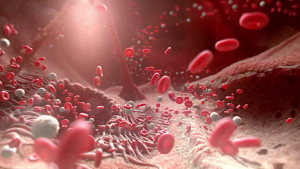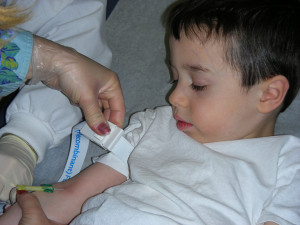 Bleeding and clotting are customary, vital processes that occur when a blood vessel wall is injured. Hemophilia is a bleeding disorder where the body is missing or deficient in one of the proteins that causes clotting. People with hemophilia bleed longer (not faster) than is typical because of a protein deficiency caused by a mutation of a gene that occurs on the X chromosome. These proteins or “clotting factors” react for blood to clot. If a clotting factor is missing or present in a decreased amount, the clotting reaction will be delayed or may not occur, resulting in prolonged bleeding. Most hemophilia bleeds are internal, into joints or soft tissue. Repeated joint bleeds may lead to permanent joint damage. Bleeding into internal organs or in the head or neck may be life threatening.
Bleeding and clotting are customary, vital processes that occur when a blood vessel wall is injured. Hemophilia is a bleeding disorder where the body is missing or deficient in one of the proteins that causes clotting. People with hemophilia bleed longer (not faster) than is typical because of a protein deficiency caused by a mutation of a gene that occurs on the X chromosome. These proteins or “clotting factors” react for blood to clot. If a clotting factor is missing or present in a decreased amount, the clotting reaction will be delayed or may not occur, resulting in prolonged bleeding. Most hemophilia bleeds are internal, into joints or soft tissue. Repeated joint bleeds may lead to permanent joint damage. Bleeding into internal organs or in the head or neck may be life threatening.
 Over 20,000 people in the US have hemophilia and roughly 400,000 people worldwide. There is no cure for hemophilia presently but the clinical strategy to treat hemophilia has been shown to be highly effective – replace the missing factor by infusing a clotting factor replacement product into the bloodstream. For almost everyone with hemophilia, infusing (an appropriate) clotting factor replacement product works to control or prevent bleeds.
Over 20,000 people in the US have hemophilia and roughly 400,000 people worldwide. There is no cure for hemophilia presently but the clinical strategy to treat hemophilia has been shown to be highly effective – replace the missing factor by infusing a clotting factor replacement product into the bloodstream. For almost everyone with hemophilia, infusing (an appropriate) clotting factor replacement product works to control or prevent bleeds.

A man (XY) with hemophilia has an affected (mutated) gene on his X-chromosome, which his daughter (XX) will inherit, while his son (XY) will not. Women (XX) have a much smaller risk of hemophilia. Women have two X chromosomes (one of which may include the mutated gene). Their (non-mutated) gene on their other X-chromosome may do its job appropriately (instruct cells to produce clotting factor). However, it is not uncommon for women who carry a hemophilia gene mutation to exhibit bleeding symptoms. Furthermore, women who carry the hemophilia gene mutation risk passing it on to 50% of their children (on average, 50% of their sons will be affected and 50% of their daughters will carry the mutated gene). Most children born today with hemophilia have a normal life expectancy. Two important standards of care have repeatedly been shown to be effective in helping affected people live normal lives: appropriate use of clotting factor and regular care from a multidisciplinary, professional team at a Hemophilia Treatment Center.


